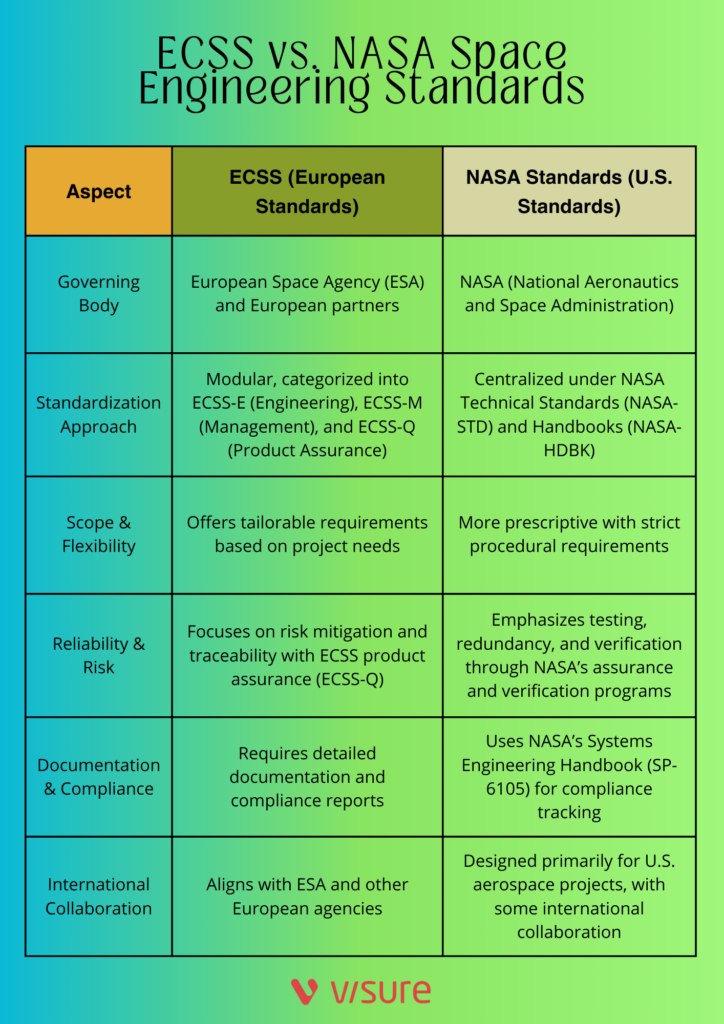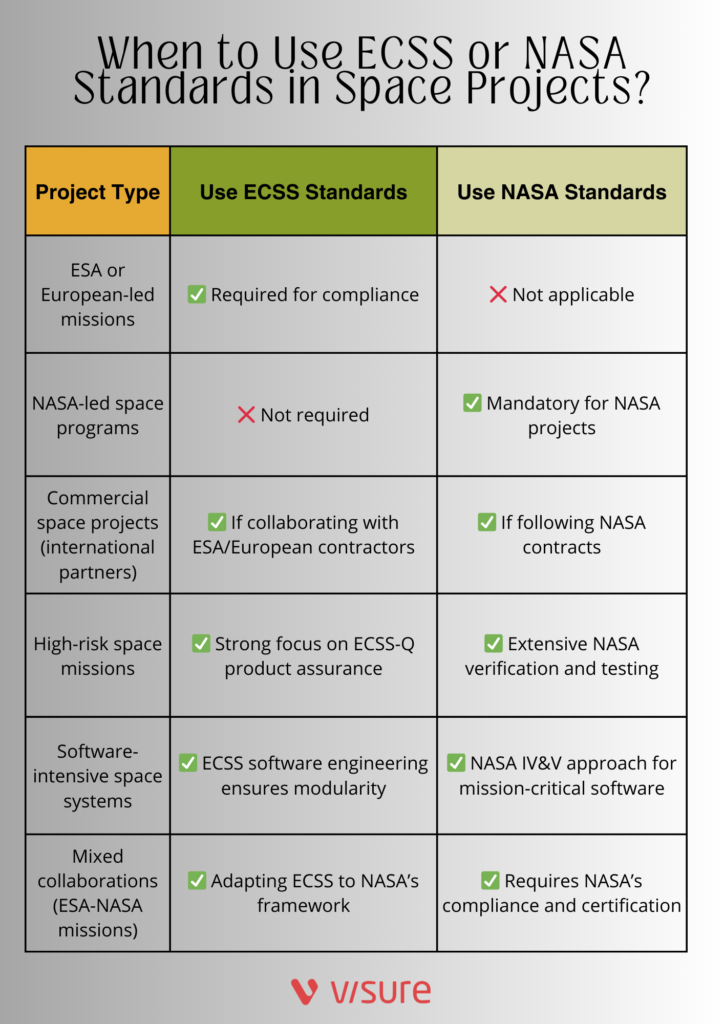Introduction
The European Cooperation for Space Standardization (ECSS) plays a crucial role in ensuring the reliability, safety, and efficiency of space systems across Europe. Established to harmonize space engineering standards, ECSS provides a structured framework for space system development, software engineering, product assurance, and project management.
With stringent ECSS requirements, organizations working on space missions must comply with standardized methodologies for design, testing, and quality assurance. These ECSS space standards help mitigate risks, improve interoperability, and streamline development processes in collaboration with agencies like the European Space Agency (ESA).
This guide explores the key ECSS documents, compliance processes, major standard categories (ECSS-E, ECSS-M, ECSS-Q), and how they compare to NASA standards. Whether you’re a space engineer, a project manager, or aerospace company, understanding ECSS regulations is essential for successful and compliant space missions.
Understanding European Cooperation for Space Standardization (ECSS) and Regulations
The European Cooperation for Space Standardization (ECSS) provides a comprehensive set of space engineering standards to ensure the safety, reliability, and quality of space system development. These ECSS documents and ECSS handbooks serve as guidelines for organizations involved in designing, testing, and managing aerospace projects.
Key ECSS documents include:
- ECSS-E-ST-10C (System Engineering) – Covers the fundamental principles of space system engineering.
- ECSS-Q-ST-10C (Product Assurance) – Focuses on space product assurance, ensuring quality and risk management.
- ECSS-M-ST-10C (Project Management) – Defines best practices for managing space engineering projects.
- ECSS Software Engineering Standards – Provides structured methodologies for software development in space missions.
- ECSS Testing Standards – Ensures rigorous testing protocols for space system validation.
These ECSS handbooks help space organizations comply with regulatory requirements while maintaining high performance and mission success rates.
Why the European Cooperation for Space Standardization (ECSS) Is Crucial for Space System Development?
Implementing ECSS space standards is essential for ensuring mission success and long-term sustainability in space projects. The benefits of ECSS standards include:
- Standardization of Engineering Practices – Establishes a unified framework for space system engineering.
- Improved Safety and Reliability – Reduces mission risks through product assurance and quality control.
- Cost Efficiency and Risk Mitigation – Prevents costly failures with standardized testing and verification.
- Global Interoperability – Aligns with ESA, NASA, and international aerospace regulations.
By following ECSS requirements, organizations can streamline development, enhance traceability, and ensure compliance with aerospace industry best practices.
ECSS Compliance and Its Role in Aerospace Projects
Achieving ECSS compliance is critical for aerospace companies, research institutions, and space agencies working on European space missions. Compliance ensures that all aspects of space system development, software engineering, and testing align with strict ECSS regulations.
Key aspects of ECSS compliance include:
- Requirement Traceability – Ensuring all ECSS requirements are properly documented and verified.
- Product Assurance & Risk Management – Implementing ECSS-Q-ST-10C to maintain high-quality space components.
- Software & Systems Engineering – Following ECSS software engineering standards for mission-critical software.
- Certification & Audits – Ensuring that organizations meet ECSS certification criteria for space missions.
Failure to comply with ECSS standards can lead to project delays, increased costs, and mission risks. Therefore, aerospace companies must integrate ECSS requirements into their workflows to achieve successful and fully compliant space missions.
Categories of the European Cooperation for Space Standardization (ECSS)
The European Cooperation for Space Standardization (ECSS) is structured into different categories to ensure comprehensive space system development, engineering, management, product assurance, and sustainability. These standards provide a framework for aerospace projects, ensuring compliance with high-reliability requirements for space missions.
The Engineering Standards (ECSS-E)
ECSS-E-ST-10C (System Engineering)
The ECSS-E-ST-10C standard defines the fundamental principles of system engineering for space missions. It covers:
- Requirements engineering – Establishing clear and traceable ECSS requirements for space system development.
- Design and architecture – Ensuring structured system design, modeling, and verification.
- Validation and testing – Implementing robust ECSS testing standards for mission success.
ECSS Software Engineering Principles
Software plays a critical role in space missions, and ECSS software engineering standards provide best practices for:
- Software lifecycle management – Covering development, verification, and maintenance.
- Software reliability and safety – Ensuring compliance with ECSS regulations for mission-critical software.
- Interoperability – Standardizing software interfaces across different space engineering platforms.
ECSS Testing Standards
To validate space systems, ECSS testing standards define rigorous procedures for:
- Functional testing – Ensuring system functionality meets ECSS compliance requirements.
- Environmental testing – Simulating extreme space conditions such as radiation, vacuum, and thermal changes.
- Qualification and acceptance tests – Verifying compliance with ECSS requirements before deployment.
The Management Standards (ECSS-M)
ECSS-M-ST-10C (Project Management)
The ECSS-M-ST-10C standard provides guidelines for efficient project management in space missions. It focuses on:
- Project lifecycle phases – Defining key stages in space system development.
- Risk and cost management – Identifying and mitigating risks in aerospace projects.
- Configuration and change control – Ensuring project traceability and documentation.
How ECSS Standards Impact Project Planning
- Streamlined workflows – ECSS management standards enhance coordination among teams.
- Regulatory alignment – Ensures projects meet ESA, ECSS, and global aerospace standards.
- Improved risk mitigation – Reduces mission failures through structured ECSS requirements management.
The Product Assurance Standards (ECSS-Q)
ECSS-Q-ST-10C (Product Assurance)
ECSS-Q-ST-10C establishes quality assurance principles for space systems by covering:
- Material and component selection – Ensuring high-reliability components for space engineering projects.
- Manufacturing and assembly controls – Standardizing aerospace production processes.
- Defect prevention and mitigation – Enforcing rigorous quality checks to enhance mission success.
Ensuring Quality and Reliability in Space Missions
- Mission-critical testing – Implementing ECSS compliance standards for spacecraft validation.
- Failure analysis and prevention – Addressing risks in hardware, software, and subsystems.
- Space product assurance – Guaranteeing long-term system performance and reliability.
The Sustainability & Safety Regulations
Space Environment Considerations in ECSS Regulations
- Debris mitigation – Following ECSS regulations for responsible space debris management.
- Eco-friendly materials – Implementing sustainable space system development practices.
- Long-term space mission sustainability – Ensuring systems meet future operational standards.
Risk Management and ECSS Certification
- Hazard identification and control – Managing risks in launch, orbit, and re-entry phases.
- Safety and regulatory compliance – Meeting stringent ECSS certification criteria.
- Human-rated space systems – Ensuring crew safety in manned space missions.
By following ECSS space standards, organizations can achieve full compliance, enhance engineering efficiency, and improve space system reliability. Understanding and implementing ECSS-E, ECSS-M, ECSS-Q, and sustainability regulations is essential for mission success in the highly demanding aerospace industry.
ECSS vs. NASA Standards: Key Differences
The European Cooperation for Space Standardization (ECSS) and NASA have developed their own space engineering standards to ensure mission success, reliability, and safety in space system development. While both frameworks serve similar purposes, they differ in structure, scope, and implementation.
How European Cooperation for Space Standardization (ECSS)European Cooperation for Space Standardization (ECSS) Software Engineering Differs from NASA’s Approach
Both ECSS and NASA software engineering standards emphasize reliability, verification, and validation. However, there are key differences in their methodologies:
ECSS Software Engineering (ECSS-E-ST-40C)
- The lifecycle-based approach ensures full traceability from requirements to deployment.
- Highly structured documentation for software development, validation, and testing.
- Focus on modularity and interoperability, ensuring seamless integration with ESA-led missions.
- ECSS compliance requires stringent software product assurance (ECSS-Q-ST-80C).
NASA Software Engineering (NASA-STD-8739.8)
- Risk-driven software classification, defining levels of software criticality.
- Strict coding and quality assurance practices, including NASA Software Assurance (NASA-STD-8739.9).
- Independent verification and validation (IV&V) for high-risk projects.
- Emphasis on automation and AI integration in modern NASA missions.
When to Use ECSS or NASA Standards in Space Projects
By understanding the differences between ECSS and NASA standards, space organizations can align their projects with the right compliance frameworks to achieve mission success and regulatory approval.
Conclusion
The European Cooperation for Space Standardization (ECSS) plays a crucial role in ensuring consistency, reliability, and safety in space system development. By providing a structured framework for engineering, management, and product assurance, ECSS enables aerospace organizations to streamline compliance, mitigate risks, and enhance mission success rates.
Understanding the key ECSS standards, their differences from NASA standards, and their applications in space projects allows organizations to select the right compliance framework for their missions. Whether developing software-intensive systems, managing aerospace projects, or ensuring product quality, adhering to ECSS regulations is vital for achieving full traceability and compliance in space programs.
For organizations seeking seamless compliance with ECSS standards, Visure Solutions provides a leading AI-driven Requirements Management Platform that helps teams automate compliance, enhance traceability, and streamline the entire requirements lifecycle.
Start your journey toward ECSS compliance today! Check out Visure’s 14-day free trial and experience the power of AI-driven requirements management.


